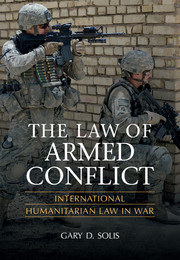Book contents
- Frontmatter
- Contents
- Table of Cases
- Table of Treaties
- Foreword
- Preface
- Acknowledgments
- LAW OF ARMED CONFLICT: INTERNATIONAL HUMANITARIAN LAW IN WAR
- 1 Rules of War, Laws of War
- 2 Codes, Conventions, Declarations, and Regulations
- 3 Two World Wars and Their Law of Armed Conflict Results
- 4 Protocols and Politics
- LAW OF ARMED CONFLICT AND INTERNATIONAL HUMANITARIAN LAW: A FRAMEWORK
- LAW OF ARMED CONFLICT AND INTERNATIONAL HUMANITARIAN LAW: BATTLEFIELD ISSUES
- References
- Index
- References
4 - Protocols and Politics
from LAW OF ARMED CONFLICT: INTERNATIONAL HUMANITARIAN LAW IN WAR
- Frontmatter
- Contents
- Table of Cases
- Table of Treaties
- Foreword
- Preface
- Acknowledgments
- LAW OF ARMED CONFLICT: INTERNATIONAL HUMANITARIAN LAW IN WAR
- 1 Rules of War, Laws of War
- 2 Codes, Conventions, Declarations, and Regulations
- 3 Two World Wars and Their Law of Armed Conflict Results
- 4 Protocols and Politics
- LAW OF ARMED CONFLICT AND INTERNATIONAL HUMANITARIAN LAW: A FRAMEWORK
- LAW OF ARMED CONFLICT AND INTERNATIONAL HUMANITARIAN LAW: BATTLEFIELD ISSUES
- References
- Index
- References
Summary
Introduction
This chapter completes the description of essential laws of armed conflict that are in effect today with discussion of Additional Protocols I, II, and III. There are other multinational treaties, Security Council pronouncements, domestic laws, appellate opinions, and military orders and regulations that bear on conduct in armed conflict but, with an awareness of 1907 Hague Regulation IV, the 1949 Geneva Conventions, and the 1977 Additional Protocols, one has the essential basics of today's jus in bello. This, in turn, allows one to determine what law applies on any battlefield.
Why New Law of Armed Conflict?
The law of armed conflict (LOAC) is young, only a hundred years having passed since modern LOAC was “formalized” in 1907 Hague Regulation IV. Whereas customary law of war finds its roots in antiquity, treaty-based battlefield law, jus in bello, is an historical youngster. Like any youthful entity, it continues to grow and mature.
Soon after the 1949 Geneva Conventions began to gather ratifications (the United States ratified in August 1955, after the U.S.-North Korean conflict ended), the international community recognized that the character of armed conflict was changing. World War II–type conflicts, large armies fighting large-scale battles involving thousands, even hundreds of thousands of troops, were giving way to guerrilla-type internal armed conflicts and revolutionary movements. Wars involving two or more states were seen less frequently, whereas non-international armed conflicts grew in number and ferocity.
- Type
- Chapter
- Information
- The Law of Armed ConflictInternational Humanitarian Law in War, pp. 119 - 146Publisher: Cambridge University PressPrint publication year: 2010



